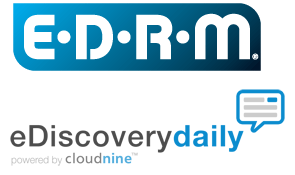eDiscovery Daily is Now an Education Partner of EDRM!

If you’re a regular reader of this blog, you know that we have frequently covered announcements by EDRM that range from announcements about new practical tools (such as those here, here and here) to announcements about new partnerships (such as this one here). We love EDRM because they regularly have something interesting to announce which gives us plenty of topic ideas for this blog. Now, EDRM’s latest announcement includes eDiscoveryDaily as we are now an Education partner of EDRM!
Having participated in EDRM since 2006, I have seen firsthand its rise to become the leading standards organization in eDiscovery and I have had the pleasure of attending several EDRM annual and mid-year meetings since then. The Electronic Discovery Reference Model has become the most recognized framework guide in eDiscovery, but it’s not the only model that EDRM members have collaborated to create, as there are five other models that have been developed and updated over the years, as well as considerably other resources, including an industry standard data set, budget calculators and a Model Code of Conduct for providers and attorneys (to name a few). Think EDRM has been busy over the 4+ years that eDiscovery Daily has existed? We have published 186 posts (and counting) related to EDRM activities and work product.
As mentioned in the announcement, eDiscovery Daily will be published daily on the EDRM site – here’s the link – and you can find the last few posts on the site. We are also listed as one of EDRM’s partners here, along with ACEDS and fellow Education partners, Bryan University and University of Florida Levin College of Law.
As part of the new partnership, eDiscovery Daily will also provide exclusive content to EDRM, including articles sharing real-life examples of organizations using EDRM resources in their own eDiscovery workflows. Look for those to appear soon on the EDRM site. Given our commitment to education at eDiscovery Daily, we are excited about teaming with EDRM to continue working to promote best practices and standards and continue to educate the legal community to manage ESI more effectively in discovery.
By the way, as we noted a couple of weeks ago, EDRM also provides free several webinars per year. Tomorrow, they are providing another one: Getting Cloud Data from the New Big Three: Google, iCloud & MS Office 365, sponsored by Zapproved. Click here for more information and for the link to register.
So, what do you think? Is an alliance between EDRM and eDiscovery Daily good for the eDiscovery industry? Please share any comments you might have or if you’d like to know more about a particular topic.
Disclaimer: The views represented herein are exclusively the views of the author, and do not necessarily represent the views held by CloudNine. eDiscoveryDaily is made available by CloudNine solely for educational purposes to provide general information about general eDiscovery principles and not to provide specific legal advice applicable to any particular circumstance. eDiscoveryDaily should not be used as a substitute for competent legal advice from a lawyer you have retained and who has agreed to represent you.





